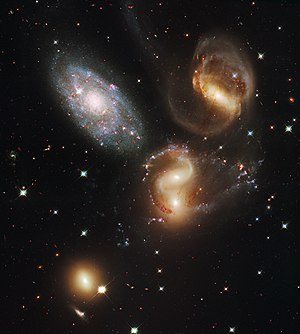Stephan's Quintet
| Stephan's Quintet | |
|---|---|

Credit: HST |
|
| Observation data (Epoch J2000) | |
| Constellation(s) | Pegasus |
| Right ascension | 22h 35m 57.5s |
| Declination | +33° 57′ 36″ |
| Brightest member | NGC 7318B |
| Number of galaxies | 5 |
| Other designations | |
| HCG 92, Arp 319, VV 288, SQ | |
Stephan's Quintet is a visual grouping of five galaxies of which four form the first compact galaxy group ever discovered. The group, visible in the constellation Pegasus, was discovered by Édouard Stephan in 1877 at the Marseille Observatory. The group is the most studied of all the compact galaxy groups. The brightest member of the visual grouping is NGC 7320 that is shown to have extensive H II regions, identified as red blobs, where active star formation is occurring.
Four of the five galaxies in Stephan's Quintet form a physical association, Hickson Compact Group 92, and will likely merge with each other. Radio observations in the early 1970s revealed a mysterious filament of emission which lies in inter-galactic space between the galaxies in the group. This same region is also detected in the faint glow of ionized atomic hydrogen seen in the visible part of the spectrum as a green arc.
Two space telescopes have recently provided new insight into the nature of the filament, which is now believed to be a giant intergalactic shock-wave (similar to a sonic boom but traveling in intergalactic gas rather than air) caused by one galaxy (NGC 7318B) falling into the center of the group at several millions of kilometers per hour.
As NGC 7318B collides with gas in the group, a huge shock wave bigger than the Milky Way spreads throughout the medium between the galaxies, heating some of the gas to temperatures of millions of degrees where they emit X-rays detectable with the NASA Chandra X-ray Observatory.
The NASA Spitzer Space Telescope, which detects infrared radiation, discovered a very powerful molecular hydrogen signal from the shock wave between the galaxies. This emission is one of the most turbulent formations of molecular hydrogen ever seen, and the strongest emission originates near the center of the green area in the visible light picture discussed earlier. This phenomenon was discovered by an international team led by scientists at the California Institute of Technology and including scientists from Australia, Germany and China. The detection of molecular hydrogen from the collision was initially unexpected because the hydrogen molecule is very fragile and is easily destroyed in shock waves of the kind expected in Stephan's Quintet. However, one solution is that when a shock front moves through a cloudy medium like the center of the group, millions of smaller shocks are produced in a turbulent layer, and this can allow molecular hydrogen to survive.
...
Wikipedia
